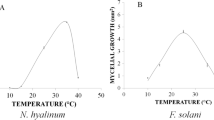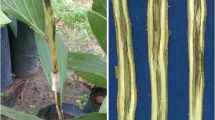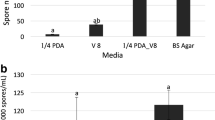Abstract
Black dot is an important disease of potato that affects all plant parts. The causal agent,Colletotrichum coccodes, is commonly found on potato tubers used for seed. Our objective was to determine thein vitro sensitivity ofC. coccodes to the fungicides maneb, thiabendazole, imazalil and CGA 173506, a phenylpyrrole. These fungicides are currently used, or are being tested for use, as potato seed treatments in the United States. All four fungicides reduced radial growth, sclerotial germination and spore germination ofC. coccodes at 10 μg/ml and higher. The fungicide concentrations that inhibited radial growth by 50% were 2 μg/ml, 5 μg/ml, 35 μg/ml, and 40 μg/ml for imazalil, CGA 173506, maneb and thiabendazole, respectively. TBZ was less inhibitory than the other three fungicides and stimulated sclerotial productionin vitro. Isolates ofC. coccodes differed in their sensitivity to maneb, thiabendazole and imazalil in radial growth, but not spore and sclerotial germination, assays. On CGA 173506, radial growth of fourC. coccodes isolates was inhibited, but these isolates produced sectors which grew normally. Germination of most sclerotia from these isolates was inhibited, but some germinated and produced normal colonies in the presence of CGA 173506. OneC. coccodes isolate was resistant to this fungicide in all assays.
Compendio
El “punto negro” de la papa es una enfermedad importante del cultivo que afecta a todas las partes de la planta. El agente causal, Colletotrichum coccodes, se encuentra comunmente sobre los tubérculos utilizados para semilla. Nuestro objetivo fue determinar la sensibilidad in vitro de C. coccodes a los fungicidas maneb, thiabendazole (TBZ), imazalil y CGA 173506, un fenilpirrol. Estos fungicidas son utilizados actualmente, o están siendo probados para su utilización como tratamientos de semilla de papa en los Estados Unidos. Los cuatro redujeron el crecimiento radial, la germinación de los esclerocios y la germinación de las esporas de C. coccodes a 10 υg/cm3 y mayores concentraciones. Las concentraciones de los fungicidas que inhibieron el crecimiento radial en un 50% fueron 2 μ/cm3, 5 μg/cm3, 35 μg/cm3 y 40 μg/cm3 para imazalil, CGA 173506, maneb y thiabendazole, respectivamente. TBZ fue menos inhibitorio que los otros tres fungicidas y estimuló la producción in vitro de esclerocios. Los aislamientos de C. coccodes difieren en su sensibilidad a maneb, thiabendazole e imazalil en el crecimiento radial, pero no en las pruebas de germinación de esporas y esclerocios. Sobre CGA173506, fue inhibido el crecimiento radial de cuatro de los aislamientos de C. coccodes, pero estos aislamientos produjeron sectores que crecieron normalmente. La germinación de la mayoría de los esclerocios de estos aislamientos fue inhibida, pero algunos germinaron y produjeron colonias normales en presencia de CGA 173506. Un aislamiento de C. coccodes fue resistente a este fungicida en todos los ensayos.
Similar content being viewed by others
Literature Cited
Barkdoll, A.W. and J.R. Davis. 1992. Distribution ofColletotrichum coccodes in Idaho and variation in pathogenicity on potato. Plant Disease 76:131–135.
Blakeman, J.P. and D. Hornby. 1966. The persistence ofColletotrichum coccodes andMycosphaerella lingulicola in soil, with special reference to sclerotia and conidia. Trans Brit Mycol Soc 49:227–240.
Carvalho, P.C.T. 1969. Heterokaryosis inColletotrichum falcatum Went. Proc International Soc of Sugar Cane Res 13:1251–1261.
Chesters, C.G.C and D. Hornby. 1965. Studies onColletotrichum coccodes. I. The taxonomic significance of variation in isolates from tomato roots. Trans Brit Mycol Soc 48:573–581.
Colquhoun, T.T. 1941. Black dot root rot of tomatoes. J Agric of South Australia 44:572–575.
Dashwood, E.P., R.A. Fox, and D.A. Perry. 1992. Effect of inoculum source on root and tuber infection by potato blemish disease fungi. Plant Pathology 41:215–223.
Davis, J.R. 1981. Black dot of potato, p. 55–56In: Compendium of Potato Diseases. (W.J. Hooker, Ed.). Am Phytopath Soc, St. Paul, MN., 125 pp.
Dillard, H.R. 1988. Influence of temperature, ph, osmotic potential and fungicide sensi tivity on germination of conidia and growth from sclerotia ofColletotrichum coccodes in vitro. Phytopathology 78:1357–1361.
Dillard, H.R. 1990. Survival ofColletotrichum coccodes in New York. Phytopathology 80:1026 (abstract).
Farley, J.D. 1972. A selective medium for assay ofColletotrichum coccodes in soil. Phytopa thology 62:1288–1293.
Farley, J.D. 1976. Survival ofColletotrichum coccodes in soil. Phytopathology 66:640–641.
Garber, E.D. and S.K. Dutta. 1962. Evidence for mixed cytoplasm in heterokaryons ofColletotrichum lagenarium. Science 135:665–666.
Gehmann, K., R. Nyfeler, A.J. Leadbeater, D. Nevill, and D. Sozzi. 1990. CGA173506: A new phenylpyrrole fungicide for broad-spectrum disease control. Proceedings 1990 Brighton Crop Protection Conference — Pests and Diseases:399–406.
Griffée, P.J. 1973. Resistance to benomyl and related fungicides inColletotrichum musae. Trans Brit Mycol Soc 60:433–439.
Hilbur, U.W. 1992. Comparative studies on genetic variability and fungicide resistance in Botryotinia fuckelianna (de bary) Whetzel against vinclozolin and the phenylpyrrole CGA 173506. Basel, Switzerland: Univ Basel; 78 p. Dissertation.
Hornby, D. 1968. Studies onColletotrichum coccodes. III. Some properties of the fungus in soil and in tomato roots. Trans Brit Mycol Soc 51:541–553.
Hunger, R.M. and G.A. McIntyre. 1979. Occurrence, development and losses associated with silver scurf and black dot on Colorado potatoes. Am Potato J 56:289–306.
Jellis, G.J. and G.S. Taylor. 1974. The relative importanceof silver scurf and black dot: Two disfiguring diseases of potato tubers. ADAS Q Rev 14:53–61.
Komm, D.A. and W.R. Stevenson. 1978. Tuber-borne infection ofSolanum tuberosum ‘Su perior’ byColletotrichum coccodes. Plant Dis Rptr 62:682–687.
Marais, L. 1990. Efficacy of fungicides againstColletotrichum coccodes on potato tubers. Potato Research 33:275–281.
Masel, A., K. Braithwaite, J. Irwin and J. Manners. 1990. Highly variable molecular karyo-types in the plant pathogenColletotrichum gleosporioides. Curr Genet 18:81–86.
Mooi, J.C. 1959. A skin necrosis occurring on potato tubers affected by black dot (Colletotrichum atramentarium) after exposure to low temperatures. Eur Potato J 2:58–68.
Ramos A.H. and Kamidi. 1982. Determination and significance of the mutation rate ofColletotrichum coffeanum from benomyl sensitivity to benomyl tolerance. Phytopathol ogy 72: 181–185.
Read, P.J. 1991. The susceptibility of tubers of potato cultivars to black dot (Colletotrichum coccodes (Wallr.) Hughes). Ann Appl Biol 119:475–482.
TeBeest, D.O.et al. 1989. The number of nuclei in spores of three species ofColletotrichum. Mycologia 81:147–149.
Wasilwa, L., J.C. Correl and T.E. Morelock. 1991. Relationship between vegetative (heter okaryon) compatibility groups and races ofColletotrichum orbiculare. Phytopathology 81:1191.
Author information
Authors and Affiliations
Rights and permissions
About this article
Cite this article
Uribe, E., Loria, R. Response ofColletotrichum coccodes to fungicidesin vitro . American Potato Journal 71, 455–465 (1994). https://doi.org/10.1007/BF02849099
Accepted:
Issue Date:
DOI: https://doi.org/10.1007/BF02849099




